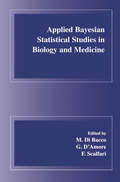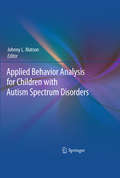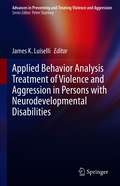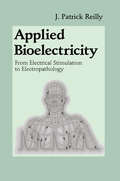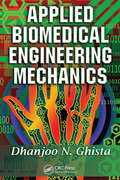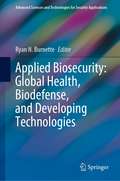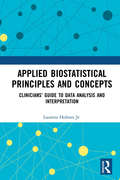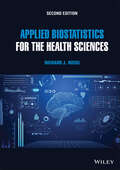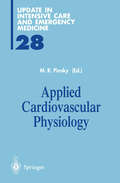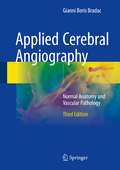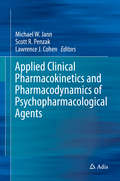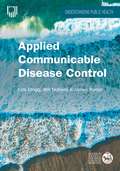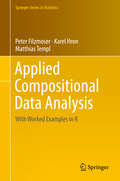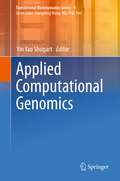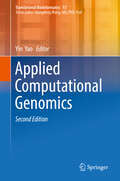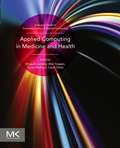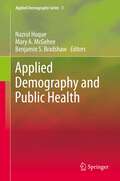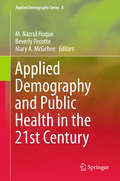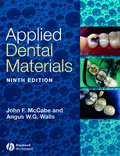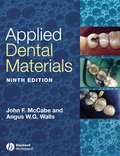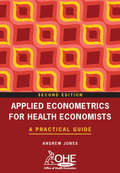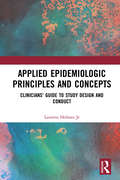- Table View
- List View
Applied Bayesian Statistical Studies in Biology and Medicine
by F. Scalfari M. Di Bacco G. D'AmoreThis volume presents the results of biological and medical research with the statistical methods used to obtain them. Nowadays the fields of biology and experimental medicine rely on techniques for processing of experimental data and for the evaluation of hypotheses. It is increasingly necessary to stimulate awareness of the importance of statistical techniques (and of the possible traps that they can hide) by using real data in concrete situations drawn from research activity.
Applied Behavior Analysis for Children with Autism Spectrum Disorders
by Johnny L. MatsonAutism was once thought of as a rare condition, until the Centers for Disease Control and Prevention’s Autism and Developmental Disabilities Monitoring Network released the statistic that about 1 in every 150 eight-year-old children in various areas across the United States is afflicted by an autism spectrum disorder, or ASD. This news led to a dramatic expansion of research into autism spectrum disorders and to the emergence of applied behavior analysis (ABA) as the preferred method of treatment, even among prescribing practitioners. Applied Behavioral Analysis for Children with Autism Spectrum Disorders ably synthesizes research data and trends with best-practice interventions into a comprehensive, state-of-the-art resource. Within its chapters, leading experts review current ABA literature in depth; identify interventions most relevant to children across the autism spectrum; and discuss potential developments in these core areas: Assessment methods, from functional assessment to single case research designs. Treatment methods, including reinforcement, replacement behaviors, and other effective strategies. The role of the differential diagnosis in ABA treatment planning. Specific deficit areas: communication, social skills, stereotypies/rituals. Target behaviors, such as self-injury, aggression, adaptive and self-help problems. ASD-related training concerns, including maintenance and transition issues, and parent training programs. This volume is a vital resource for researchers, graduate students, and professionals in clinical child and school psychology as well as the related fields of education and mental health.
Applied Behavior Analysis Treatment of Violence and Aggression in Persons with Neurodevelopmental Disabilities (Advances in Preventing and Treating Violence and Aggression)
by James K. LuiselliThis book focuses on applied behavior analysis (ABA) treatment of violence and aggression in persons with neurodevelopmental disabilities. It details ABA theory and concepts leading to empirical treatment procedures that can be implemented successfully across diverse treatment settings. Further, the book examines contemporary approaches to functional behavioral assessment (FBA) and functional analysis (FA) in determining the environmental conditions responsible for violence and aggression. In addition, the volume describes several evidence-supported treatment procedures that encompass antecedent-control, contingency management, cognitive-behavior therapy, and physical intervention components. It addresses effective strategies for training and supervising care providers, including behavioral skills training (BST), posttraining performance management, and mindfulness. Finally, the book presents recommendations that guide effective and socially valid research-to-practice translation. Applied Behavior Analysis Treatment of Violence and Aggression in Persons with Neurodevelopmental Disabilities is an essential resource for researchers, clinicians/therapists, and upper-level undergraduate and graduate students in forensic psychology, public health, criminology/criminal justice, and behavioral therapy and rehabilitation.
Applied Bioelectricity: From Electrical Stimulation to Electropathology
by J. Patrick ReillyElectric currents and electromagnetic fields have been applied to biological systems, particularly humans, with both therapeutic and pathological results. This text discusses biological responses to electric currents and electromagnetic fields, including medical applications and shock hazards. It covers fundamental physical and engineering principles of responses to short-term electrical exposure and emphasises human reactions, although animal responses are considered as well, and the treatment covers reactions from the just-detectable to the clearly detrimental. An important new chapter discusses standards for human exposure to electromagnetic fields and electric current and demonstrates how these standards have been developed using the principles treated in earlier chapters.
Applied Biomedical Engineering Mechanics
by Dhanjoo GhistaCombining topics from numerous applications in biomechanics, Applied Biomedical Engineering Mechanics demonstrates how to analyze physiological processes from an engineering perspective and apply the results to tertiary medical care. The book extends its discussion to the investigation of diagnostic and surgical procedures. It also presents guideli
Applied Biosecurity: Global Health, Biodefense, and Developing Technologies (Advanced Sciences and Technologies for Security Applications)
by Ryan N. BurnetteThis book describes an adaptable biothreat assessment process to complement overall biorisk management programs, incorporating threat management and the unique natures of biological assets. Further, this book examines the nexus between public health, international security, and developing technologies, building a case for augmenting biosecurity to levels beyond the laboratory constraints. With the face of biological and biomedical sciences changing, this book describes how with proper biosecurity development, these can become assets, rather than liabilities, to secure our world from natural and man-made biological disasters. The world is changing rapidly with respect to developing threats, such as terrorism, and dual-use technologies, such as synthetic biology, that are challenging how we think about biosafety and biosecurity. Further, the fields of public health and international security are colliding, as both of these share the common enemy: intentional or natural biological incidents. To date, biosecurity has been limited to laboratory-level application, and complicating efforts, and lacks credentialed biosecurity professionals skilled in both the biological sciences and threat management techniques. The result is a fragmented field of practice, with tremendous need, from the lab to the outbreak. Underpinning these principles is the SARS-CoV-2 coronavirus pandemic, providing a historic milestone to examine biosecurity through a global lens. This book describes biosecurity as a set of practices and principles to be augmented out of the constrained laboratory environment, and applied to larger efforts, such as international threat reduction and biological incident management.
Applied Biostatistical Principles and Concepts: Clinicians' Guide to Data Analysis and Interpretation
by Laurens Holmes, Jr.The past three decades have witnessed modern advances in statistical modeling and evidence discovery in biomedical, clinical, and population-based research. With these advances come the challenges in accurate model stipulation and application of models in scientific evidence discovery Applied Biostatistical Principles and Concepts provides practical knowledge using biological and biochemical specimen/samples in order to understand health and disease processes at cellular, clinical, and population levels. Concepts and techniques provided will help researchers design and conduct studies, then translate data from bench to clinics in attempt to improve the health of patients and populations. This book is suitable for both clinicians and health or biological sciences students. It presents the reality in statistical modelling of health research data in a concise manner that will address the issue of "big data" type I error tolerance and probability value, effect size and confidence interval for precision, effect measure modification and interaction as well as confounders, thus allowing for more valid inferences and yielding results that are more reliable, valid and accurate.
Applied Biostatistical Principles and Concepts: Clinicians' Guide to Data Analysis and Interpretation
by Laurens Holmes, Jr.The past three decades have witnessed modern advances in statistical modeling and evidence discovery in biomedical, clinical, and population-based research. With these advances come the challenges in accurate model stipulation and application of models in scientific evidence discovery Applied Biostatistical Principles and Concepts provides practical knowledge using biological and biochemical specimen/samples in order to understand health and disease processes at cellular, clinical, and population levels. Concepts and techniques provided will help researchers design and conduct studies, then translate data from bench to clinics in attempt to improve the health of patients and populations. This book is suitable for both clinicians and health or biological sciences students. It presents the reality in statistical modelling of health research data in a concise manner that will address the issue of "big data" type I error tolerance and probability value, effect size and confidence interval for precision, effect measure modification and interaction as well as confounders, thus allowing for more valid inferences and yielding results that are more reliable, valid and accurate.
Applied Biostatistics for the Health Sciences
by Richard J. RossiAPPLIED BIOSTATISTICS FOR THE HEALTH SCIENCES APPLIED BIOSTATISTICS FOR THE HEALTH SCIENCES In this newly revised edition of Applied Biostatistics for the Health Sciences, accomplished statistician Dr. Richard Rossi delivers a robust and easy-to-understand exploration of statistics in the context of applied health science and biostatistics. The book covers sample design, logistic regression, experimental design, survival analysis, basic statistical computation, and many more topics with a strong focus on the correct use and interpretation of statistics. The author also explains how to assess the quality of observed data, how to collect quality data, and the use of confidence intervals in conjunction with hypothesis and significance tests. A thorough introduction to biostatistics, including explanations of fundamental concepts like populations, samples, statistics, biomedical studies, and data set examples A comprehensive exploration of population descriptions, including qualitative and quantitative variables, multivariate data, measures of dispersion, and probability Practical discussions of random sampling, summarizing random samples, and the measurement of the reliability of statistics In-depth examinations of confidence intervals, statistical hypothesis testing, simple and multiple linear regression, and experimental design Perfect for health science and biostatistics students and professors at the upper undergraduate and graduate levels, Applied Biostatistics for the Health Sciences is also a must-read reference for practitioners and professionals in the fields of pharmacy, biochemistry, nursing, health care informatics, and the applied health sciences.
Applied Biostatistics for the Health Sciences
by Richard J. RossiAPPLIED BIOSTATISTICS FOR THE HEALTH SCIENCES APPLIED BIOSTATISTICS FOR THE HEALTH SCIENCES In this newly revised edition of Applied Biostatistics for the Health Sciences, accomplished statistician Dr. Richard Rossi delivers a robust and easy-to-understand exploration of statistics in the context of applied health science and biostatistics. The book covers sample design, logistic regression, experimental design, survival analysis, basic statistical computation, and many more topics with a strong focus on the correct use and interpretation of statistics. The author also explains how to assess the quality of observed data, how to collect quality data, and the use of confidence intervals in conjunction with hypothesis and significance tests. A thorough introduction to biostatistics, including explanations of fundamental concepts like populations, samples, statistics, biomedical studies, and data set examples A comprehensive exploration of population descriptions, including qualitative and quantitative variables, multivariate data, measures of dispersion, and probability Practical discussions of random sampling, summarizing random samples, and the measurement of the reliability of statistics In-depth examinations of confidence intervals, statistical hypothesis testing, simple and multiple linear regression, and experimental design Perfect for health science and biostatistics students and professors at the upper undergraduate and graduate levels, Applied Biostatistics for the Health Sciences is also a must-read reference for practitioners and professionals in the fields of pharmacy, biochemistry, nursing, health care informatics, and the applied health sciences.
Applied Cardiovascular Physiology (Update in Intensive Care and Emergency Medicine #28)
by Prof. Dr. Michael R. Pinsky1A concise yet complete overview of the treatment of cardiovascular instability in the critically ill patient. The authors consider all aspects, ranging from basic physiology and pathophysiology to diagnostic tools and established and novel forms of therapy. The whole is rounded off with an integration of these principles into a series of clinically relevant scenarios.
Applied Cerebral Angiography: Normal Anatomy and Vascular Pathology
by Edoardo Boccardi Gianni Boris BradacThis book offers detailed guidance on the diagnostic use of cerebral angiography based on precise description of the angiographic appearances of normal anatomy and pathological conditions. In this third edition, every chapter has been thoroughly revised and enlarged to reflect new knowledge and experiences, and more attention is paid to the correlations between anatomopathological findings and clinical manifestations. Beyond explaining the diagnostic value of cerebral angiography, a key aim is to equip readers with the precise knowledge of the anatomy of cerebral vessels required for optimal application of endovascular therapy of pathologies involving the arteries and veins of the brain. As in preceding editions, the book is divided into two parts. The first part describes the normal anatomy, with attention to morphological aspects, embryological development, function, and vascular territories. The intraorbital and extracranial vascularization is also fully considered. The knowledge provided will serve as a sound basis for the correct interpretation of pathological processes and their clinical significance, as covered in depth in the second part of the book.
Applied Clinical Pharmacokinetics and Pharmacodynamics of Psychopharmacological Agents
by Michael W. Jann Scott R. Penzak Lawrence J. CohenThis book is a comprehensive resource on psychotropic medications, detailing the latest methods for defining their characteristics, their use in different patient populations, and drug-drug interactions; an important collection of information forclinicians, students, researchers, and members of the pharmaceutical industry alike. The first section provides the foundational principles of these drugs. Mathematical modeling of parameters that affect their entryto,and exit from, the central nervous system (CNS) compartment are presented on an individual basis and then applied to target populations with specific disease states. Methods and characteristics that inform the transfer of these drugs from the laboratory bench to use in patient care are discussed, including imaging techniques, genetics and physiological barriers, such as the blood-brain barrier. The second section describes the characteristics of specific agents,nominally arranged intodifferent therapeutic categories and with reference crossover use in different disease states. The pharmacologic characteristics of different drug formulations are explored in the context of their ability to improve patient adherence. The third section focuses on drug-drug interactions.Psychotropic medications from different categories are frequently prescribed together,or alongside medications used to treat comorbid conditions, and the information provided is directly relevant to the clinic, as a result. The clinical application of pharmacokinetics and pharmacodynamics of CNS agents has made significant progress over the past 50 years and new information is reported by numerous publications in psychiatry, neurology, and pharmacology.Our understanding of the interrelationship between these medications, receptors, drug transporters, as well as techniques for measurement and monitoring their interactions,isfrequently updated. However, with information presented on a host of different platforms, and in different formats, obtaining the full picture can be difficult. This title aims to collate this information into a single source that can be easily interpreted and applied towards patient care by the clinical practitioner, and act as a reference for all others who have an interest in psychopharmacological agents.
Applied Communicable Disease Control (UK Higher Education OUP Humanities & Social Sciences Health & Social Welfare)
by Liza Cragg Will Nutland James RudgeUnderstanding Public Health is an innovative series published by Open University Press in collaboration with the London School of Hygiene & Tropical Medicine, where it is used as a key learning resource for postgraduate programmes. It provides self-directed learning covering the major issues in public health affecting low-, middle- and high-income countries.Communicable diseases are ever present in the world today. Social and economic issues like poverty, access to essential vaccinations and lack of substantive healthcare systems contribute to mortality rates alongside epidemiological factors like portals of entry and bacterial sources.This public health textbook, in exploring the causes and conditions of communicable diseases like Ebola and malaria, clearly outlines communicable disease control and prevention measures as well as how to apply these measures effectively in different contexts and populations around the world.The result is an engaging and insightful textbook that encourages readers to apply their learning of communicable disease control to diverse applied settings through case studies and activities. It is balanced in its approach, discussing infections and their incidence alongside the means of prevention and the vital conditions for effective response in outbreak situations. Applied Communicable Disease Control is key reading for all those working in, or studying, public health and epidemiology.Series Editors: Rosalind Plowman and Nicki Thorogood.
Applied Compositional Data Analysis: With Worked Examples In R (Springer Series in Statistics)
by Peter Filzmoser Matthias Templ Karel HronThis book presents the statistical analysis of compositional data using the log-ratio approach. It includes a wide range of classical and robust statistical methods adapted for compositional data analysis, such as supervised and unsupervised methods like PCA, correlation analysis, classification and regression. In addition, it considers special data structures like high-dimensional compositions and compositional tables. The methodology introduced is also frequently compared to methods which ignore the specific nature of compositional data. It focuses on practical aspects of compositional data analysis rather than on detailed theoretical derivations, thus issues like graphical visualization and preprocessing (treatment of missing values, zeros, outliers and similar artifacts) form an important part of the book. Since it is primarily intended for researchers and students from applied fields like geochemistry, chemometrics, biology and natural sciences, economics, and social sciences, all the proposed methods are accompanied by worked-out examples in R using the package robCompositions.
Applied Computational Genomics (Translational Bioinformatics #1)
by Yin Yao Shugart"Applied Computational Genomics" focuses on an in-depth review of statistical development and application in the area of human genomics including candidate gene mapping, linkage analysis, population-based, genome-wide association, exon sequencing and whole genome sequencing analysis. The authors are extremely experienced in the area of statistical genomics and will give a detailed introduction of the evolution in the field and critical evaluations of the advantages and disadvantages of the statistical models proposed. They will also share their views on a future shift toward translational biology. The book will be of value to human geneticists, medical doctors, health educators, policy makers, and graduate students majoring in biology, biostatistics, and bioinformatics. Dr. Yin Yao Shugart is investigator in the Intramural Research Program at the National Institute of Mental Health, Bethesda, Maryland USA.
Applied Computational Genomics (Translational Bioinformatics #13)
by Yin YaoThe volume provides a review of statistical development and application in the area of human genomics, including candidate gene mapping, linkage analysis, population-based genome-wide association, exon sequencing, and whole genome sequencing analysis. The authors are extremely experienced in the field of statistical genomics and will give a detailed introduction to the evolution of the field, as well as critical comments on the advantages and disadvantages of the proposed statistical models. The future directions of translational biology will also be described.
Applied Computing in Medicine and Health (Emerging Topics in Computer Science and Applied Computing)
by Abir Hussain Dhiya Al-Jumeily Conor Mallucci Carol OliverApplied Computing in Medicine and Health is a comprehensive presentation of on-going investigations into current applied computing challenges and advances, with a focus on a particular class of applications, primarily artificial intelligence methods and techniques in medicine and health. Applied computing is the use of practical computer science knowledge to enable use of the latest technology and techniques in a variety of different fields ranging from business to scientific research. One of the most important and relevant areas in applied computing is the use of artificial intelligence (AI) in health and medicine. Artificial intelligence in health and medicine (AIHM) is assuming the challenge of creating and distributing tools that can support medical doctors and specialists in new endeavors. The material included covers a wide variety of interdisciplinary perspectives concerning the theory and practice of applied computing in medicine, human biology, and health care. Particular attention is given to AI-based clinical decision-making, medical knowledge engineering, knowledge-based systems in medical education and research, intelligent medical information systems, intelligent databases, intelligent devices and instruments, medical AI tools, reasoning and metareasoning in medicine, and methodological, philosophical, ethical, and intelligent medical data analysis.Discusses applications of artificial intelligence in medical data analysis and classifications Provides an overview of mobile health and telemedicine with specific examples and case studies Explains how behavioral intervention technologies use smart phones to support a patient centered approachCovers the design and implementation of medical decision support systems in clinical practice using an applied case study approach
Applied Demography and Public Health (Applied Demography Series #3)
by Nazrul Hoque, Mary A. McGehee and Benjamin S. BradshawThis book combines the disciplines of applied demography and public health by describing how applied demographic techniques can be used to help address public health issues. Besides addressing the impact of aging on health and health-related expenditure, cause-specific mortality, and maternal health and morbidity, the book provides several chapters on special analysis and methodological issues. The chapters provide a number of resources and tools that can be used in conducting research aimed at promoting public health. These resources include information on a variety of health research datasets, different statistical methodologies for analyzing health-related data and developing concepts related to health status, methodologies for forecasting or projecting disease incidences and associated costs, and discussions of demographic concepts used to measure population health status.
Applied Demography and Public Health in the 21st Century (Applied Demography Series #8)
by M. Nazrul Hoque Beverly Pecotte Mary A. McGeheeThis book demonstrates different statistical techniques for analyzing health-related data as well as providing new techniques for forecasting and/or projecting the incidence of diseases/disorders. It presents information on a variety of health related issues from the developed and developing world. Featuring cutting edge research from distinguished applied demographers and public health specialists, the book bridges the gap between theory and research. Each chapter provides methods and materials that can be used to conduct further research aimed at promoting public health issues. This book is intended for public health professionals, health policy makers, social epidemiologists, administrators, researchers, and students in the fields of applied demography and public health who are interested in exploring the potential of ground-breaking research or who want to further develop their existing research techniques. It complements another volume in the Applied Demography Series, Applied Demography and Public Health (Springer, 2013), which describes how applied demographic techniques can be used to help address public health issues.
Applied Dental Materials
by John F. McCabe Angus W.G. WallsThis textbook covers all aspects of materials science relevant to the practice of dentistry. It is aimed primarily at undergraduate dental students, although it will also be useful for practising dentists, dental technicians and dental assistants. The 9th edition has been extensively revised to include the many advances in dental materials and their use that have occurred during the past nine years. The chapters on Resin-based filling materials and Adhesive restorative materials have been expanded significantly with new coverage of fibre reinforcement of composite structures and polymerisable luting agents. A brand new chapter has been added on endodontic materials.
Applied Dental Materials
by John F. McCabe Angus WallsThis textbook covers all aspects of materials science relevant to the practice of dentistry. It is aimed primarily at undergraduate dental students, although it will also be useful for practising dentists, dental technicians and dental assistants. The 9th edition has been extensively revised to include the many advances in dental materials and their use that have occurred during the past nine years. The chapters on Resin-based filling materials and Adhesive restorative materials have been expanded significantly with new coverage of fibre reinforcement of composite structures and polymerisable luting agents. A brand new chapter has been added on endodontic materials.
Applied Econometrics for Health Economists: A Practical Guide
by Andrew Jones"Applied Econometrics for Health Economists" introduces readers to the appropriate econometric techniques for use with different forms of survey data, known collectively as microeconometrics. The book provides a complete illustration of the steps involved in doing microeconometric research. The only study to deal with practical analysis of qualitat
Applied Epidemiologic Principles and Concepts: Clinicians' Guide to Study Design and Conduct
by Laurens Holmes, Jr.This book provides practical knowledge to clinicians and biomedical researchers using biological and biochemical specimen/samples in order to understand health and disease processes at cellular, clinical, and population levels. Concepts and techniques provided will help researchers design and conduct studies, then translate data from bench to clinics in attempt to improve the health of patients and populations. This book presents the extreme complexity of epidemiologic research in a concise manner that will address the issue of confounders, thus allowing for more valid inferences and yielding results that are more reliable and accurate.
Applied Epidemiologic Principles and Concepts: Clinicians' Guide to Study Design and Conduct
by Laurens Holmes, Jr.This book provides practical knowledge to clinicians and biomedical researchers using biological and biochemical specimen/samples in order to understand health and disease processes at cellular, clinical, and population levels. Concepts and techniques provided will help researchers design and conduct studies, then translate data from bench to clinics in attempt to improve the health of patients and populations. This book presents the extreme complexity of epidemiologic research in a concise manner that will address the issue of confounders, thus allowing for more valid inferences and yielding results that are more reliable and accurate.
